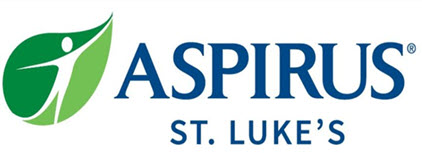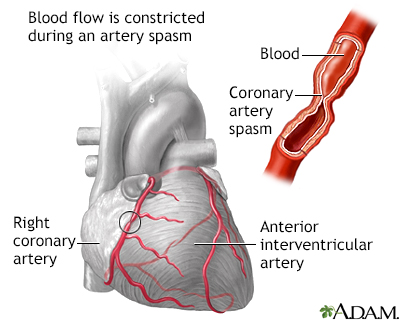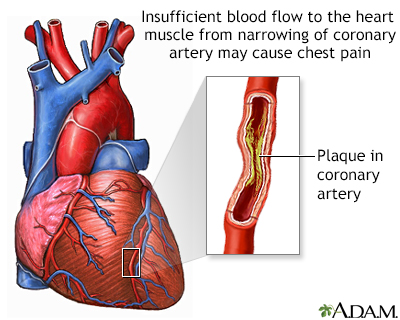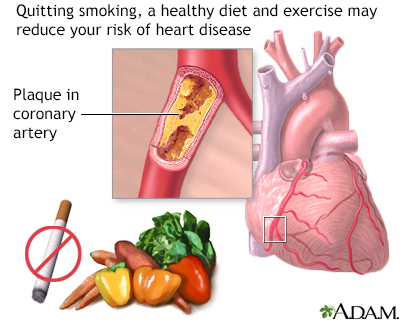Coronary artery spasm
Variant angina; Angina - variant; Prinzmetal angina; Vasospastic angina; Chest pain - PrinzmetalThe coronary arteries supply blood and oxygen to the heart. Coronary artery spasm is a brief, sudden narrowing of one of these arteries.
Causes
Coronary artery spasm often occurs in coronary arteries that have not become hardened due to plaque buildup. However, it also can occur in arteries with plaque buildup.
These spasms are due to a squeezing of muscles in the artery wall. They most often occur in just one area of the artery. The coronary artery may appear normal during testing, but it does not function normally at other times.
About 2% of people with angina (chest pain and pressure) have coronary artery spasm.
Angina
Angina is a type of chest discomfort or pain due to poor blood flow through the blood vessels (coronary arteries) of the heart muscle (myocardium). ...

Coronary artery spasm occurs most commonly in people who smoke or who have high cholesterol or high blood pressure. It may occur without cause, or it may be triggered by:
High cholesterol
Cholesterol is a fat (also called a lipid) that your body needs to work properly. Too much bad cholesterol in your blood can increase your chance of...

High blood pressure
Blood pressure is a measurement of the force exerted against the walls of your arteries as your heart pumps blood to your body. Hypertension is the ...

-
Alcohol withdrawal
Alcohol withdrawal
Alcohol withdrawal refers to symptoms that may occur when a person who has been drinking too much alcohol on a regular basis suddenly stops drinking ...
Read Article Now Book Mark Article - Emotional stress
Stress
Stress is a feeling of emotional or physical tension. It can come from any event or thought that makes you feel frustrated, angry, or nervous. Stres...
 ImageRead Article Now Book Mark Article
ImageRead Article Now Book Mark Article - Exposure to cold
- Medicines that cause narrowing of the blood vessels (vasoconstriction)
Vasoconstriction
Vasoconstriction is the narrowing (constriction) of blood vessels by small muscles in their walls. When blood vessels constrict, blood flow is slowe...
 ImageRead Article Now Book Mark Article
ImageRead Article Now Book Mark Article - Stimulant drugs, such as amphetamines and cocaine
Cocaine use and cigarette smoking can cause severe spasms of the arteries. This causes the heart to work harder. In many people, coronary artery spasm may occur without any other heart risk factors (such as smoking, diabetes, high blood pressure, and high cholesterol).
Symptoms
Spasm may be "silent" (without symptoms) or it may result in chest pain or angina. If the spasm lasts long enough, it may even cause a heart attack.
Heart attack
Most heart attacks are caused by a blood clot that blocks one of the coronary arteries. The coronary arteries bring blood and oxygen to the heart. ...

The main symptom is a type of chest pain called angina. Typically, the chest pain feels like tightness, heavy pressure, squeezing, or a crushing feeling. It may spread to the:
- Arm (most often the left)
- Back
- Jaw
- Neck
- Shoulder
Some people say the pain feels like gas or indigestion. It is most often severe. The pain may spread to the neck, jaw, shoulder, or arm.
The pain of coronary artery spasm:
- Often occurs at rest
- May occur at the same time each day, usually between midnight and 8:00 a.m.
- Lasts from 5 to 30 minutes
The person may lose consciousness.
Chest pain and shortness of breath due to coronary artery spasm are often not caused by exercise, unlike angina that is caused by hardening of the coronary arteries.
Exams and Tests
Tests to diagnose coronary artery spasm may include:
-
Coronary angiography
Coronary angiography
Coronary angiography is a procedure that uses a special dye (contrast material) and x-rays to see how blood flows through the arteries in your heart....
 ImageRead Article Now Book Mark Article
ImageRead Article Now Book Mark Article -
Electrocardiogram (ECG)
Electrocardiogram
An electrocardiogram (ECG) is a test that records the electrical activity of the heart.
 ImageRead Article Now Book Mark Article
ImageRead Article Now Book Mark Article - Echocardiography
Treatment
The goal of treatment is to control chest pain and prevent a heart attack. A medicine called nitroglycerin (NTG) can relieve an episode of pain.
Your health care provider may prescribe other medicines to prevent chest pain. You may need long term treatment with a type of medicine called a calcium channel blocker or a long-acting nitrate.
Beta-blockers are another type of medicine that is used with other coronary artery problems. However, beta-blockers may make coronary artery spasm worse. They should be used with care.
If you have this condition, you should avoid coronary artery spasm triggers. These include exposure to cold, cocaine or amphetamine use, cigarette smoking, and high-stress situations.
Outlook (Prognosis)
Coronary artery spasm is a long-term (chronic) condition. However, treatment most often helps control symptoms.
Chronic
Chronic refers to something that continues over an extended period of time. A chronic condition is usually long-lasting and does not easily or quick...

The disorder may be a sign that you have a high risk for heart attack or deadly irregular heart rhythms. The outlook is most often good if you follow your treatment, your provider's advice, and avoid certain triggers.
Possible Complications
Complications may include:
- Abnormal heart rhythms, which may cause cardiac arrest and sudden death
Cardiac arrest
Cardiac arrest occurs when the heart suddenly stops beating. When this happens, blood flow to the brain and the rest of the body also stops. Cardia...
Read Article Now Book Mark Article - Heart attacks
When to Contact a Medical Professional
Immediately call the local emergency number (such as 911) or go to the hospital emergency room if you have a history of angina and the crushing or squeezing chest pain is not relieved by nitroglycerin. The pain may be due to a heart attack. Rest and nitroglycerin often do not completely relieve the pain of a heart attack.
A heart attack is a medical emergency. If you have symptoms of a heart attack, seek medical help right away.
Prevention
Take steps to reduce your risk of developing heart disease. Some studies have shown that making a few lifestyle changes can reduce your risk for heart disease. Lifestyle changes can also help prevent some angina attacks. Your provider may tell you to:
- Lose weight if you are overweight
- Stop smoking
- Exercise regularly
- Drink alcohol in moderation only
- Eat a healthy diet that is high in vegetables, fruits, whole grains, fish, and lean meats
References
Boden WE. Angina pectoris and chronic ischemic heart disease. In: Goldman L, Cooney KA, eds. Goldman-Cecil Medicine. 27th ed. Philadelphia, PA: Elsevier; 2024:chap 56.
Bonaca MP, Sabatine MS. Approach to the patient with chest pain. In: Libby P, Bonow RO, Mann DL, Tomaselli GF, Bhatt DL, Solomon SD, eds. Braunwald's Heart Disease: A Textbook of Cardiovascular Medicine. 12th ed. Philadelphia, PA: Elsevier; 2022:chap 35.
Giugliano RP, Braunwald E. Non-ST elevation acute coronary syndromes. In: Libby P, Bonow RO, Mann DL, Tomaselli GF, Bhatt DL, Solomon SD, eds. Braunwald's Heart Disease: A Textbook of Cardiovascular Medicine. 12th ed. Philadelphia, PA: Elsevier; 2022:chap 39.
Lange RA, Mukherjee D. Acute coronary syndrome: unstable angina and non-ST elevation myocardial infarction. In: Goldman L, Cooney KA, eds. Goldman-Cecil Medicine. 27th ed. Philadelphia, PA: Elsevier; 2024:chap 57.
Writing Committee Members; Gulati M, Levy PD, Mukherjee D, et al. 2021 AHA/ACC/ASE/CHEST/SAEM/SCCT/SCMR Guideline for the evaluation and diagnosis of chest pain: A Report of the American College of Cardiology/American Heart Association Joint Committee on Clinical Practice Guidelines. J Am Coll Cardiol. 2021;78(22):e187-e285. PMID: 34756653 pubmed.ncbi.nlm.nih.gov/34756653/.
-
Angina causes and symptoms
Animation
-
Angina - illustration
Angina is a specific type of pain in the chest caused by inadequate blood flow through the blood vessels (coronary vessels) of the heart muscle (myocardium).
Angina
illustration
-
Coronary artery spasm - illustration
Coronary artery spasm is a temporary constriction of an artery in the heart. The spasm can slow or stop blood flow through the artery. The main symptom experienced is chest pain.
Coronary artery spasm
illustration
-
Artery cut section - illustration
The structure of blood vessel walls is important in the regulation of blood flow. The tunica media contains smooth muscle fibers which contract to either dilate or constrict the size of the vessel. These small changes in the vessel lumen can greatly influence blood pressure and blood flow. Therefore, the tunica media plays an important role in maintaining blood pressure and continuous blood circulation.
Artery cut section
illustration
-
Prevention of heart disease - illustration
Heart disease may be prevented by recommended healthy diet, regular exercise and to stop smoking if you are a smoker. Follow your health care provider's recommendations for treatment and prevention of heart disease.
Prevention of heart disease
illustration
-
Angina - illustration
Angina is a specific type of pain in the chest caused by inadequate blood flow through the blood vessels (coronary vessels) of the heart muscle (myocardium).
Angina
illustration
-
Coronary artery spasm - illustration
Coronary artery spasm is a temporary constriction of an artery in the heart. The spasm can slow or stop blood flow through the artery. The main symptom experienced is chest pain.
Coronary artery spasm
illustration
-
Artery cut section - illustration
The structure of blood vessel walls is important in the regulation of blood flow. The tunica media contains smooth muscle fibers which contract to either dilate or constrict the size of the vessel. These small changes in the vessel lumen can greatly influence blood pressure and blood flow. Therefore, the tunica media plays an important role in maintaining blood pressure and continuous blood circulation.
Artery cut section
illustration
-
Prevention of heart disease - illustration
Heart disease may be prevented by recommended healthy diet, regular exercise and to stop smoking if you are a smoker. Follow your health care provider's recommendations for treatment and prevention of heart disease.
Prevention of heart disease
illustration
Review Date: 1/1/2025
Reviewed By: Michael A. Chen, MD, PhD, Associate Professor of Medicine, Division of Cardiology, Harborview Medical Center, University of Washington Medical School, Seattle, WA. Also reviewed by David C. Dugdale, MD, Medical Director, Brenda Conaway, Editorial Director, and the A.D.A.M. Editorial team.










